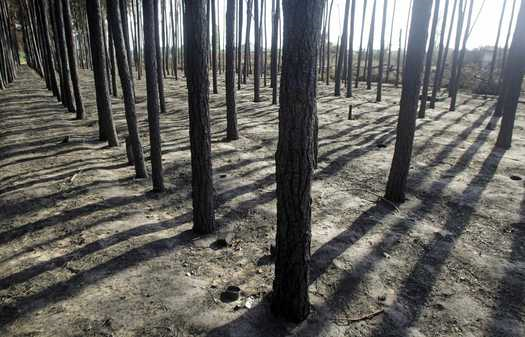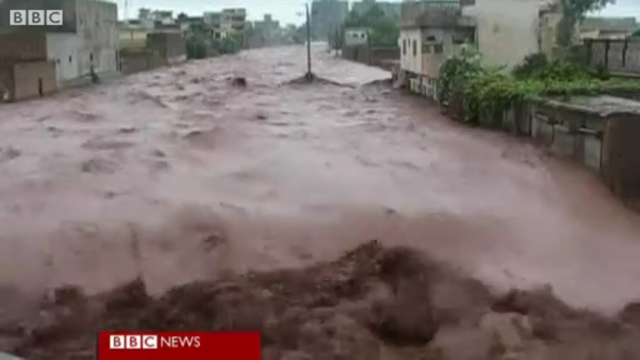WMO: Unprecedented sequence of extreme weather events is consistent with climate change
Last updated: 11 August 2010 Several regions of the world are currently coping with severe weather-related events: flash floods and widespread flooding in large parts of Asia and parts of Central Europe while other regions are also affected: by heatwave and drought in Russian Federation, mudslides in China and severe droughts in sub-Saharan Africa. While a longer time range is required to establish whether an individual event is attributable to climate change, the sequence of current events matches IPCC projections of more frequent and more intense extreme weather events due to global warming. The Monsoon activity in Pakistan and other countries in South-East Asia is aggravated by the la Niña phenomenon, now well established in the Pacific Ocean. The Pakistan Meteorological Department (PMD) has been issuing warnings since the onset of the pre-Monsoon season in mid-June and issues continuous weather and flood advisories and warnings to assist in emergency relief (http://www.pakmet.com.pk) Heavy and persistent rainfall has been recorded since July causing severe flash floods and widespread flooding. The event affected first the north-western part of Pakistan and later extended to large parts of the country, with Khyber-Pakhtonkwa, Punjab and Sindh among the most affected provinces. The province of Khyber-Pakhtonkwa received nearly 180 % excess of total July rainfall compared to the monthly long-term average. According to Roshydromet, the Russian Federal Service for Hydrometeorology and Environmental Monitoring, July 2010 is the warmest month ever in Moscow since the beginning of modern meteorological records, 130 years ago. Temperature has exceeded the long-term average by 7.8° C (compared to the previous record in July 1938 with 5.3° C above average). Record high temperatures varying between 35° C and 38.2° C were registered for more than 7 consecutive days end July, with the heatwave continuing into August. The daily temperature of 38.2° C on 29 July was the highest ever in Moscow (compared to a long-term average of approximately 23° C). The minimum temperature of nearly 25°C (recorded during the night before sunrise) also scored a significant increase compared to the historical average of about 14° C. Those temperatures are characteristic for a heatwave of a rare intensity and duration.
The World Meteorological Organization coordinates the global collection of climate data for long-term scientific research. The Organization, with its partners, is working towards a Global Framework for Climate Services, decided upon in 2009 by World Climate Conference-3, to provide information and services for adapting to climate change. Several diverse extreme weather events are occurring concurrently around the world, giving rise to an unprecedented loss of human life and property. They include the record heatwave and wildfires in the Russian Federation, monsoonal flooding in Pakistan, rain-induced landslides in China, and calving of a large iceberg from the Greenland ice sheet. These should be added to the extensive list of extreme weather-related events, such as droughts and fires in Australia and a record number of high-temperature days in the eastern United States of America, as well as other events that occurred earlier in the year. The heatwave in the European part of the Russian Federation is associated with a persistent pressure ridge that appeared in June 2010. Initially, it was associated with the Azores high, but later was reinforced by a strong inflow of warm air from the Middle East. More than 20 daily temperature records were broken including the absolute maximum temperature in Moscow. The high temperatures triggered massive forest and peat fires in the European part of the country. Some villages were burned completely, with smoke and smog adversely and greatly affecting the health and well-being of tens of millions of people. The floods in Pakistan were caused by strong monsoon rains. According to the Pakistan Meteorological Department, the instant rain intensity reached 300 mm over a 36-hour period. The strong monsoon rains led to the highest water levels in 110 years in the Indus River in the northern part of the country, based on past records available from 1929. More areas in central and south Pakistan are affected by the floods. The death toll to date exceeds 1 600 and more than 6 million people have been displaced. Some reports indicate that 40 million citizens have been affected by the floods.
China is also experiencing its worst floods in decades. The recent death toll due to the mudslide in the Zhouqu county of Gansu province on 7 August 2010 exceeded 700, with more than 1 000 people missing. In addition, 12 million people are reported to have lost their homes owing to the recent floods. On 5 August 2010, the MODIS sensor on NASA’s Aqua satellite detected calving from the Petermann Glacier in northern Greenland. The largest chunk of ice to calve from the glacier in the past 50 years of observations and data (since 1962) measures more than 200 sq. km. Tens of thousands of icebergs calve yearly from the glaciers of Greenland. However, this one is very large and because of its size more typically resembles icebergs in the Antarctic. Climate extremes have always existed, but all the events cited above compare with, or exceed in intensity, duration or geographical extent, the previous largest historical events. According to Roshydromet, studies of the past climate show no record of similar high temperatures since the tenth and eleventh centuries in Ancient Russia. …



Sorry to keep posting critical comments, I do appreciate your blog. But in this case, I'm not sure that the article you quote justifies your headline. The WMO is mentioned once and no position statement on the recent extreme weather events is recorded by the article. Unless they also published something not mentioned by the article, putting them in the headline seems unwarranted.
Thanks again for your blog.
My apologies. It was not clear from the formatting of your post that the final paragraphs are a direct quote from a WMO publication, as I have just discovered. I take back my earlier comments. Sorry to bother you and you can just leave all these comments unpublished if you'd prefer.
Byron, no worries. Desdemona has a thick skin. Thanks for reading!